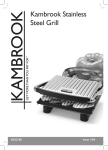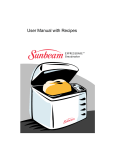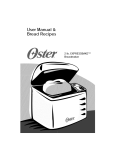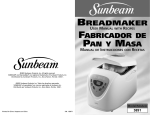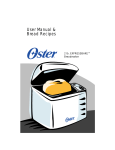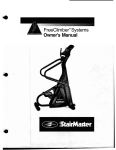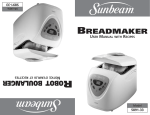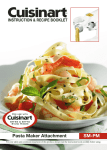Download Oster 5858 Bread Maker User Manual
Transcript
When using electrical appliances, to reduce the risk of fire, electric shock, and/or injury to persons, basic safety precautions should always be followed, including the following: l READ ALL INSTRUCTIONS, PRODUCT LABELS AND WARNINGS BEFORE USING THE BREADMAKER. l Do not touch hot surfaces. Always use oven mitts when handling hot materials, and allow metal parts to cool before cleaning. Allow the breadmaker to cool thoroughly before putting in or taking off parts. l When unit is not in use and before cleaning, unplug the breadmaker from wall outlet. l To protect against risk of electrical shock, do not immerse the appliance or plugs in water or other liquids. l Close supervision is always necessary when this or any appliance is used by or near children, or incapacitated persons. l Do not allow anything to rest on the power cord. Do not plug in cord where people may walk or trip on it. l Do not operate this or any appliance with a frayed or damaged cord, or plug, or after the appliance malfunctions or is dropped or has been damaged in any manner. Take appliance to the nearest Authorized Service Facility for examination, repair or electrical or mechanical adjustment. l Do not let the cord dangle over the edge of a table or counter or touch hot surfaces. Do not place on an unsteady or clothcovered surface. l Avoid contact with moving parts. l l Do not use attachments not recommended by the manufacturer; they may cause fire, electric shock or injury. Do not use outdoors or for commercial purposes. l Do not place the appliance near a hot gas or electric burner, or in a heated oven. l To unplug, press the “STOP” button, grip plug and pu11 from wall outlet. Never pull on the cord. l Use of Extension Cords: A short power supply cord has been provided to reduce the risk of injury resulting from becoming entangled in or tripping over a longer cord. Extension cords are available from hardware stores and may be used with care. If used, the extensi’on cord must be at least 10 amps and 120 volts. The cord should be arranged so that it will not drape over the counter or tabletop where it can be pulled by children or tripped over accidentally. If the appliance is of the grounded type, the extension cord should be grounding-type 3-wire cord. l Electrical Power: If electric circuit is overloaded with other appliances, your breadmaker may not operate properly. The breadmaker should be operated on a separate electrical circuit from other operating appliances. l Do not use appliance for other than intended use, This appliance has a polarized plug (one blade is wider than the other). To reduce the risk of electric shock, this plug is intended to fit into a polarized outlet only one way. If the plug does not fit fully into the outlet, reverse the plug. If it still does not fit, contact a qualified electrician. Do not attempt to modify the plug in any way. THIS B READMAKER Is FOR HOUSEHOLD U S E O NLY SAVE THESE INSTRUCTIONS Table of Contents Important Safeguards . . . . . . . . . . . . . . . . . . . . . . Table of Contents.. .. ... 2 4 . . . . . ... . . . . . . . . . . . . . . . . . . . . . . . Overview of Breadmaker Features ..... . . . . . . . . -,. . . ... ... . ... . . . . .6 . Using the Delay Timer . . . . . . . . . . . . . . . . . . . . . . . . . . . . . 7 Breadmaker Settings . . . . . . . . . . . . . . . . . . . . . . . . . . . . . . . 8 Tips and Hints . . . . . . . . . . . . . . . . . . . . . . . . . . . . . . . . . . . . 9 Baking at High Altitudes . . . . . . . . . . . . . . . . . . . . . . . . . . . . Learning About Your Breakmaker . . . . . . . . . . . . . . . . . . . . . Taking Care of Your Breadmaker ................. Troubleshooting . . . . . . . . . . . . . . . . . . . . . . . . . Recipes 10 . ... l l ....11 . . . . . . . . . . 12 ..................................... ...14 Basic . . . . . . . . . . . . . . . . . . . . . . . . . .... . . . . . . . . . . . . .14 ExpressBakee Setting: Bakiig Bread In Under 1 Hour . . . . . . 15 .. . . ExpressBakee . . . . . . . . . . . . . . . . . . . . . . . . . . . . . . . . . . . 17 Whole Wheat . . . . . . . . . . . . . . . . . . . . . . . . . . . . . . . . . . . . French 18 ........................19 Sweet....................................20 Quick . . . . . . . . . . . . . . . . . . . . . . . . . . . . . . . . . . . . . . .21 Dough . . . . . . . . . . . . . . . . . . . . . . . . . . . . . . . . . . . . ...22 Warranty Information . . . . . . . . . . . . . . . . .....................23 Learning About Your Breadmaker 2 4 6 7 8 . 9 . 10 . ll . 11 , . 12 . . 14 . . 14 . . 1.5 . . 17 . .18 . . 19 . . .20 . ..21 . . .22 . . .23 1. Place the breadmaker on a counter where the plug will reach an outlet. DO NOT plug the machine into the wall outlet yet. You will be shown later when to do this. Make sure you can open the breadmaker top without hitting the top of kitchen cabinets. 2. Open the lid and remove the bread pan. To do this, simply grasp the handle of the pan and pull straight up. Use a gentle, non-abrasive soap and wash, rinse and dry the pan thoroughly. 3. Attach the kneading blade to the bread pan, as shown. You will find the kneading blade in a small plastic wrap attached to the power cord. 4. Set the bread pan aside. Do not yet place the pan into the breadmaker. Important After a baking cycle, the bread machine will not operate until it has cooled down. Important The breadmaker has an automatic “keep warm” setting that will keep your bread warm for up to.one hour. To turn warmer off, press the “StartfStop” button and hold until you hear a beep. Important Do NOT press the “Start/Stop” button while the breadmaker is making bread. This will cause the machine will turn off and you will need to start over again, from scratch. Caution: The breadmaker is very hot. Do not handle the machine while it is operating. Do NOT lift the lid while the breadmaker is baking bread. Overview of Breadmaker Features 1 Menu Press this button to select the kind of bread you want to make. Each time you press the button you will hear a beep. The display shows a number for each setting. For example, Basic is 1, Whole Wheat is 2, French is 3, etc. 2 Crust Color Button The Crust Color button allows you to choose how light or dark to make the crust of the bread. Each time you press the Crust Color button the display will change as follows: P-Medium = P H-Dark = H L-Light = L In addition, the display will show the cycle number before the crust color setting. For example, the Basic with a Medium crust reads “1P.” Or the French bread setting with a dark crust reads “3H.” 3 Display The Display shows the following settings: l The number of the bread setting cycle l The crust color setting l The time remaining while your bread is kneading or baking Once you press the “Start/Stop” button to begin, the display will show the remaining time until your bread is baked. When the display reads “0:OO” the bread is baked. 4 Timer Set Buttons Press these buttons to delay the time for your breadmaker to start. For example, you can time your bread to be ready for dinner, or to bake while you are sleeping. You may delay up to 13 hours. 5 Start/Stop Button Press this button to start and stop your breadmaker or begin countdown for delayed baking bread. If delay bake is selected, the remaining time will count down in one minue increments. / l Using the Delay Timer You can delay the time your breadmaker starts to have fresh bread ready when you get up in the morning or when you come from work. We recommend that before you use the Delay Timer, you try out a few recipes. Use recipes that have produced good results for you in the past. Important: You cannot use the Delay Timer for ExpressBake@=’ settings. Before Using the Delay Timer: 1. Add al1 recipe ingredients to the bread pan. 2. Select the correct setting for the kind of bread you are making. 3. Select the crust color. Caution: Do not use recipes with ingredients that can spoil like eggs or milk. 4. Determine how many hours and minutes there are between now and when you want final, baked bread. 5. Use the “Timer Up” button to advance the time in 10 minute increments. If necessary, use the “Timer Down” button to decrease the time. (To advance the time quickly, simply press and hold down the “Timer Up/Down" buttons.) Important: If you make a mistake or wish to start over, press and hold down the "Start/Stop" button until you hear a beep. The display will show the original setting and cycle time. The Delay Timer is canceled and you can start again. 6. When the Delay Timer is set where you want it, make sure to press the “Start/Stop” button. The colon ( : ) will flash and your bread will be ready when you planned. Important: When using the Delay Timer during times of hot weather, you may wish to reduce the liquid in your recipe by 1 or 2 tablespoons. This is to prevent the dough from rising too much. You may also reduce the Salt by 1/8 or 1/4 teaspoon and try cutting the amount of sugar you use by 1/4 teaspoon at a time. 1 Basic (3 Hours) This setting is probably used more than any other because it gives you the best results with just about any recipe. 2 Whole Wheat (4 Hours, 10 Minutes) The whole wheat setting offers a longer rise time for breads that contain more then 50% whole wheat flour. 3 French (3 Hours, 50 Minutes) / Use this setting for making French breads. French bread takes longer to knead, rise and bake, providing a heartier crust. 4 Sweet (2 Hours, 50 Minutes) The sweet setting is for baking breads with high amounts of sugar, fats and proteins, al1 of which tend to increase browning. 5 ExpressBake@ (58 Minutes) Use this setting for baking bread in under 1 hour; this setting will only bake 1.5lb. size loaves. 6 Quick (1 Hour, 43 Minutes) Use this setting for recipes that contain baking powder or baking soda rather than yeast to make bread or cake rise; only specially designed recipes are to be used for this setting. 7 Dough (1 Hour, 30 Minutes) This setting lets you prepare dough for rolls, specialty breads, pizza, etc., which you shape by hand, allow to rise, then bake in a conventional oven. 8 Bake (1 Hour) This setting is for baking dough that you may have prepared without using the previous settings. l Tips and Hints Experienced cooks consider breadmaking to be as much art as science. Keep in mind that some recipes may require a little experimentation before they are exactly the way you want them. Just dont give up. Still, there are special hints to ensuring quality bread almost every time. Use Exact Measurements Leve1 off al1 dry ingredients and make sure that al1 liquid ingredients are measured in a glass cup with the markings clearly labeled on the side. Use Fresh Ingredients You should always use fresh ingredients. The reasons are: l l Flour. If you have stored your flour for a long time, it may have become wet from absorbing moisture, or dry, depending on the area of the country in which you live. We recommend using fresh bread flour. Yeast. Fresh yeast is probably the most important ingredient in baking bread. If the yeast is not fresh, your bread may not rise. It is better to buy new yeast than to take a chance on yeast that has been stored for a long time. You can test the freshness of your yeast. Simply fil1 a cup with warm water, then add and stir in 2 teaspoons of sugar. Sprinkle a few teaspoons of yeast on the surface of the water and wait. After 15 minutes, the yeast should foam and there should be distinct odor. If neither reaction happens, the yeast is old and should be thrown away. Add Ingredients in the order given according to the recipe. Read al1 recipes from top to bottom, and remember: - FIRST: liquid ingredients - SECOND: dry ingredients - LAST: yeast Check the Doughball You may need to adjust the consistency of the dough by adding a little flour or a little water until the dough is just right. Check the breadmaker when the clock reads 2:30. If the doughball appears sticky or too wet, sprinkle in a little flour, a tablespoon at a time until the dough appears smooth. If the doughball is too dry, or you hear knocking sounds, sprinkle in water a teaspoon at a time until the doughball appears round and dry. For Baking at High Altitudes To compensate for high altitude baking, we recommend the following: If the Dough Is Too Dry l increase the amount of water to the recipe, sometimes as much as 2 - 4 Tbsp. per cup. If the Bread Rises Too High l l reduce the amount of yeast. For each tsp. of yeast, try reducing the yeast by 1/8 to 114 tsp. reduce the amount of sugar. For each Tbsp. of sugar, reduce the amount by 1 to 2 tsp. Taking Care of Your Bread Machine General Cleaning 1. Remove all bread crumbs by wiping them away with a slightly damp cloth. 2. DO NOT bend the heating element which is located on the inside of the breadmaker. Cleaning the bread pan and Kneading Blade 1. Wipe the bread pan and kneading blade with a damp cloth and dry completely. 2. DO NOT wash the pan or parts in the dishwasher. Surely this will damage the finish of the pan and the other parts. Cautionr Do not put the breadmaker in water or in a dishwasher. Do not use benzene, scrubbing brushes or chemical cleaners as these will damage the machine. Use only a mild, non-abrasive cleanser to clean the breadmaker. Caring for Your Breadmaker 1. Keep your breadmaker clean at all times. Caution: Do not use metal utensils with the breadmaker. This will damage the non-stick pan and other parts. 2. Don’t worry if the color of the bread pan changes over time. The color change is a result of steam and other moisture and does not affect the machine’s performance. 3. If you have trouble removing the kneading blade, place warm water in the bread pan for 10 - 15 minutes and this will loosen the blade. Storing Your Breadmaker 1. Make sure the machine is clean and dry before storing. 2. Store the breadmaker with the lid closed. 3. Do not place heavy objects on the lid. 4. Remove the kneading blade and place inside the bread pan. Troubleshooting If you are unable to find a solution, please call our Consumer Relations Department at l-800-458-8407. burning odor from the back of the machine. and into the machine itself. Stop the breadmaker ff. Clean the breadmaker rhe bread has a floured top. This is usually a result of using too much flour or not enough water. Try using less flour (a tsp. less at a time), or try using more water (1/4 tsp. more at a time). rhe bread is too brown. This is usually the result of adding too much sugar to the recipe. Try using less sugar ( 1 Tbsp. at a time). You can also try selecting a lighter crust color selection. The bread is not brown enough This is usually the result of repeatedly lifting the lid of the bread machine or leaving the lid open while the bread is baking. Be sure the lid is shut while the breadmaker is in operation. You can also try selecting a darker crust color selection. The sides of the bread collapse and the bottom of the bread is damp. possible solutions. The bread There are several may have been left in the bread pan too long after baking. Remove the bread from the pan sooner and allow it to cool. Try using more flour (a tsp. at a time), or less yeast (1/4 tsp. ata time), or less water or liquid (a tsp. at a time). This could also be the result of forgetting to add salt to the recipe. ‘he bread has a heavy, hick texture. -he bread is not baked :ompletely in the center. Try using more flour (a tsp. more at a time), or less water or liquid (a tsp. less at a time). DO not lift the lid too often during baking. rhe bread has a coarse texture. This is usually the result of forgetting to add salt to the recipe. rhe bread rose too much. Try using less yeast (1/4 tsp. less at a time). This could also be the result of forgetting to add salt to the recipe or forgetting to put the kneading blade into the bread pan. ‘he bread did not rise enough. There are severa1 possible solutions. Try using less flour (a tsp. less at a time), more yeast (1/4 tsp. more at a time), or less water (a tsp. less at a time). This could also be the result of: r r - lid In. Br !ad w3 an 3 - Try using less flour (a tsp. at a time), or more yeast (1/4 tsp. at a time). This could also be the result of using old flour or the wrong type of flour for the recipe. l l l l forgetting to add salt to the recipe using old flour or the wrong kind of flour for the recipe using old yeast usíng water that is too hot (except otherwise noted in the r e c i p e s a n d f o r ExpressBake” setting recipes). Basic Setting Recipe Homestyle White Bread MAKES ONE 1-lb LOAF 3/4 cup + 2 Tbsp. water (7585°F) l-1/2 Tbsp. butter or margarme, softened l-1/2 Tbsp. sugar 1 Tbsp. non-fat dry milk powder l-1/2 tsp. salt 3 cups bread flour l-1/2 tsp. bread machine yeast 1. Spray the bread pan and kneading blade with non-stick cooking spray. Attach the kneading blade in the bread pan. Place ingredients in the bread pan in the following order: water, butter, sugar, milk powder, Salt and flour. 2. With finger, make a small indentation at one side of the flour. Add yeast to indentation, making sure it does not come in’contact with the liquid ingredients. 3. Insert bread pan into breadmaker; gently close lid. Plug the power cord into a wall unit. Press the Menu Button until the “Basic” program is reached. Press the “Loaf” button and set it for l-1/2 lb. loaf. Press the “Crust Color” button for the desired crust color. Press the Start button. 4. When the machine beeps, indicating that program has finished, lift the lid and, using oven mitts, firmly grasp the bread pan handle and gently pull the pan straight up and out of the machine. Unplug the breadmaker and let cool. cwc A U T I O N : The breadmaker and pan may be very hot! Always handle with care. 5. If needed, use a non-stick spatula to gently loosen the sides of the bread from the pan; turn bread pan upside down onto a wire cooling rack and gently shake until bread falls out onto rack. 6. Turn bread right-side up on rack and coo1 about 20 minutes before slicing. IMPORTANT: After a baking cycle, the bread machine will not operate until it has cooled down. ExpressBake@ Setting: Making Bread In Under 1 Hour Your OSTER” breadmaker can bake great bread in under 1 hour. This is called the “ExpressBake@” setting. ExpressBake@ loaves are a little different from loaves baked on other settings. ExpressBake@ i x. Setting: l This setting can bake bread in 58 minutes. The bread is a little more dense in texture with this setting. l The ExpressBake@ setting will only make a 1.5lb. loaf. There are a few things you should know about the ExpressBake@ settings that are different than the other settings. 1to l ExpressBakeB breads tend to have a darker, thicker crust than other kinds of bread. Sometimes there will be a crack in the top of the crust. This is because baking is done at higher temperatures. They also tend to be shorter, denser loaves. l You CANNOT use the Delay Timer for the ExpressBake@ settings. This would cool the liquid ingredients and affect the way that the bread rises. l You CANNOT use the “Crust Color” option for ExpressBake@ breads. . DO NOT open the cover while making ExpressBake@ breads. l If the loaf is hard to remove from the pan, let it sit for about 5 minutes to cool. Gently shake the bread out of the pan and wait for 15 minutes before slicing. l If you wish to bake another loaf of bread, you must let the breadmaker co01 for 20 minutes with the cover open. l YOU CAN use standard bread mixes for ExpressBake@ breads, but the results may not be as good as the results when using the recipe within this manual. or” .nd, an ‘ES il Yeast Always use a fast-rising yeast. DO NOT use active dry yeast for ExpressBake@ settings because the loaves will be much shorter when baked. 11) 15 ml Liquids Always use hot water in the range of ll.S”-125”F/46”-52°C. You must use a cooking thermometer to gauge the temperature; hotter water can kill the yeast while cooler water may not activate it. Salt As a rule, you should use LESS salt for ExpressBakeB bread?. Less salt provides you with a higher loaf. Make sure to follow the recipe suggestions in this booklet for best results. Other Ingredients Make sure al1 other ingredients (like flour, sugar, dry milk, butter, etc.} are at room temperature. Always use bread flour for the ExpressBake@ settinas. Things You May Need to Buy l l You should only use “Bread Machine” flour for the ExpressBake@ recipes. You may need a cooking thermometer to measure the temperature of the water you use in these recipes. You should only use hot water (between 115°F and 125°F OY 46” and SZT) for ExpressBakeB recipes. Although baking ExpressBake@ bread is a little different, the results and convenience are well Worth it. ExpressBake’ Setting Recipe ExpressBake@ Toasting-Style White Bread MAKFS ONE 1.5Ib LOAF The ExpressBake” program produces a slightly denser bread that is perfect for toasting. 1 cup + 2 Tbsp. hot water (115125°F) 2 Tbsp. canola or vegetable oil 2 Tbsp. sugar 1 tsp. salt 3 cups bread flour 5 tsp. bread-machine yeast 1. Spray the bread pan and kneading blade with non-stick cooking spray. Attach the kneading blade in the bread pan. Place ingredients into the bread pan in the following order: water, oil, sugar, salt and flour. 2. With finger, make a small indentation at one side of the flour. Add yeast to indentation, making sure it does not come in contact with the liquid ingredients. 3. Insert bread pan into breadmaker; gently close lid. Plug the power cord into a wall outlet. Press the Menu button until the “ExpressBake@” program is reached. Press the start button. 4. When the machine beeps, indicating that program has finished, lift the lid and, using oven mitts, firmly grasp the bread pan handle and gently pull the pan straight up and out of the machine. Unplug the breadmaker and let cool. @FC AUTION: The breadmaker and pan may be very hot! Always handle with care. 5. If needed, use a non-stick spatula to gently loosen the sides of the bread from the pan; turn bread pan upside down onto a wire cooling rack and gently shake until bread falls out onto rack. 6. Turn bread right-side up on rack and cool about 20 minutes before slicing. Whole Wheat Setting Recipe Whole Wheat Bread MAKES ONE 1.5lb L OAF 1 cup + 2 Tbsp. water (7585°F) 1 Tbsp. + l-1/2 tsp. butter or margarine, softened 1/4 cup firmly packed light brown sugar l-1/4 tsp. salt 3-1/2 cups whole wheat flour 2-1/4 tsp. bread machine yeast 1. Spray bread pan and kneading blade with non-stick cooking spray. Attach the kneading blade in the bread pan. Place ingredients in bread pan in the following order: water, butter, sugar, salt and flour. 2. With fingen make a small indentation at one side of the flour. Add yeast to indentation, making sure it does not come in contact with the liquid ingredients. 3. Insert bread pan into breadmaker; gently close lid. Plug the power cord into a wall outlet. Press the Menu Button until the “Whole Wheat” program is reached. Press the “Loaf” button and set it for l-1/2 lb. loaf. Press the “Crust Color” button for the desired crust color. Press the Start button. 4. When the machine beeps, indicating that program has finished, lift the lid and, using oven mitts, firmly grasp the bread pan handle and gently pull the pan straight up and out of the machine. Unplug the breadmaker and let cool. IGFCA U T I O N : The breadmaker and pan may be very hot! Always handle with care. 5. If needed, use a non-stick spatula to gently loosen the sides of the bread from the pan; turn bread pan upside down onto a wire cooling rack and gently shake until.bread falls out onto rack. 6. Turn bread right-side up on rack and cool about 20 minutes before slicing. French Setting Recipe Classic French Bread MAKES ONE 1.5lb LOAF 1 cup + 1 Tbsp. water (7585°F) 2 tsp. sugar 3/4 tsp. salt 3-1/3 cups bread flour 2 tsp. bread machine yeast 1. Spray the bread pan and kneading blade with non-stick cooking spray. Attach the kneading blade in the bread pan. Place ingredients in the bread pan in the following order: water, sugar, salt and flour. 2. With finger, make a small indentation at one side of the flour. Add yeast to indentation, making sure it does not come in contact with the liquid ingredients. 3. Insert bread pan into breadmaker; gently close lid. Plug the power cord into a wall unit. Press the Menu Button until the “French Bread” program is reached. Press the “Loaf” button and set it for l-1/2 lb. loaf. Press the “Crust Color” button for the desired crust color. Press the Start button. 4. When the machine beeps, indicating that program has finished, lift the lid and, using oven mitts, firmly grasp the bread pan handle and gently pull the pan straight up and out of the machine. Unplug the breadmaker and let cool. USC A U T I O N : The breadmaker and pan may be very hot! Always handle with care. l / 5. If needed, use a non-stick spatula to gently loosen the sides of the bread from the pan; turn bread pan upside down onto a wire cooling rack and gently shake until bread falls out onto rack. 6. Turn bread right-side up on rack and cool about 20 minutes before before slicing. Sweet Setting Recipe Banana-Pecan Bread MAKES O NE 1.5lb LOAF 1/2 cup + 1 Tbsp. water (7585°F) 3/4 cup mashed ripe banana, about 2 medium bananas 2 Tbsp. butter or margarine, softened 1 large egg, lightly beatea 3 Tbsp. sugar l-1/4 tsp. salt 3-1/4 cups bread flour 2-1/4 tsp. bread machine yeast 1/2 cup chopped pecans 1. Spray bread pan and kneading blade with non-stick cooking spray. Attach the kneading blade in the bread pan. Place ingredients in bread pan in the following order: water, banana, butter, egg, sugar, salt then flour. 2. With finger, make a small indentation at one side of the flour. Add yeast to indentation, making sure it does not come in contact with the liquid ingredients. Sprinkle nuts over flour. 3. Insert bread pan into breadmaker; gently close lid. Plug the power cord into a wall outlet. Press the Menu Button until the “Sweet Bread” program is reached. Press the “Loaf” button and set it for l-l/2 lb. loaf. Press the “Crust Color” button for the desired crust color. Press the Start button. 4. When the machine beeps, indicating that program has finished, lift the lid and, using oven mitts, firmly grasp the bread-pan handle and gently pull the pan straight up and out of the machine. Unplug the breadmaker and let cool. tWC A U T I O N : The breadmaker and pan may be very hot! Always handle with care. 5. If needed, use a non-stick spatula to gently loosen the sides of the bread from the pan; turn bread pan upside down onto a wire cooling rack and gently shake until bread falls out onto rack. 6. Turn bread right-side up on rack and coo1 about 20 minutes before before slicing. Quick Setting Recipe Chock Full o’ Chocolate Walnut-Zucchini Bread MAKES ONE 1.S-lb LOAF 1/2 cup chopped walnuts 3/4 cup sugar l/2 cup semi-sweet chocolate pieces 1 tsp. ground cinnamon 2 cups all-purpose flour, divided 1 tsp. grated orange pee1 3 large eggs, lightly beaten 1/2 tsp. salt l/3 cup canola or vegetable oil I/2 tsp. ground allspice 2 tsp. baking powder 2-1/2 cups shredded zucchini, about 2 medium zucchini 1 tsp. baking soda 1. In a small bowl, combine walnuts and chocolate pieces; add 2 Tbsp. of the flour and toss well; set aside. 2. Spray the bread pan and kneading blade with non-stick cooking spray. Attach the kneading blade in the bread pan. In the pan, place eggs, oil, the remaining flour, the baking powder, baking soda, sugar, cinnamon, orange peel, salt and allspice. Add zucchini, then the floured walnuts and chocolate pieces along with any flour remaining in the bowl. 3. Insert bread pan into breadmaker; gently close lid. Plug the power cord into a wall outlet. Press the Menu Button until the “Quick Bread” program is reached. Press the Start button. 4. When the machine beeps, indicating that program has finished, lift the lid and, using oven mitts, firmly grasp the bread-pan handle and gently pull the pan straight up and out of the machine. Unplug the breadmaker and let cool. ( cwc AUTION: The breadmaker and pan may be very hot! Always handle with care. 5. If needed, use a non-stick spatula to gently loosen the sides of the bread from the pan; turn bread pan upside down onto a wire cooling rack and gently shake until bread falls out onto rack. 6. Turn bread right-side up on rack and cool about 20 minutes before before slicing. Dough Setting Recipe Basic Pasta Dough MAKES ABOUT I-lb. 2 cups al1 purpose flour 1 cup semolina flour 1 tsp. salt 1 Tbsp. olive or canola oil 3/4 cup + 2 Tbsp. water (75-85” F.) 1. Spray bread pan and kneading blade with non-stick cooking spray. Attach the kneading blade in the bread pan. Place ingredients in the bread pan in the following order: flour and Salt. 2. With finger, make a small indentation at one side of the flour. Add oil to indentation, then add water on top. 3. Insert bread pan into breadmaker; gently close lid. Plug the power cord into a wall outlet. Press the Menu Button until the “Dough” prográm is reached. Press the Start button, and let machine run for 10-12 minutes until ingredients form a ball. If needed, use a rubber spatula to push any loose flour or dough scraps in the corners of pan toward the kneading blade. 4. Press the Stop button. Lift lid and remove dough to a large floured cutting board. I-SC A U T I O N : The breadmaker and pan may be very hot! Always handle with care. 5. Feed dough through a pasta machine or rol1 out to 1/8-inch thickness. If dough is sticky, dust lightly with flour. 6. If cutting by hand, cut into 1/8-inch strips for narrow pasta or I/4-inch strips for wider pasta. 7. Place cut pasta on a rack or on semolina-dusted cutting board to dry, about 2 hours. l 8. Cook pasta in a large pot of boiling, salted water for 3-5 minutes or until of desired doneness. Two-Year Limited Warranty Sunbeam Products, Inc. (“Sunbeam”) warrants that for a period of two years from the date of purchase, this product will be free from defects in material and workmanship. Sunbeam, at its option, will repair or replace this product or any component of the product found to be defective during this warranty period. Replacement will be made with a new or remanufactured product or component. If the product is no longer available, replacement may be made with a similar product of equal or greater value. This is your exclusive warranty. This warranty is valid for the original retail purchaser from the date of initial retail purchase and is not transferable. Keep the original sales receipt. Proof of purchase is required to obtain warranty performance. Sunbeam dealers, service centers or retail stores selling Sunbeam products do not have the right to aher, modify or in any way change the terms and conditions of this warranty. , / l This warranty does not cover normal wear of parts or damage resulting from any of the following: negligent use or misuse of the product, use on improper voltage or current, use contrary to the operating instructions, disassembly, repair or alteration by anyone other than Sunbeam or an Authorized Service Center. Further, the warranty does not cover acts of nature, such as fire, flood, hurricanes and tornadoes. Sunbeam shall not be hable for any incidental or consequential damages caused by the breach of any express or implied warranty. Except to the extent prohibited by applicable law, any implied warranty of merchantability or fitness for a particular purpose is limited in duration to the duration of the above warranty. Some states, provinces or jurisdictions do not allow the exclusion or limitation of incidental or consequential damages or limitations on how long an implied warranty lasts, so the above limitations of exclusion may not apply to you. This warranty gives you specific legal rights, and you may also have other rights that vary from state to state or province to province. How to Obtain Warranty Service Take the product to an Authorized Sunbeam Service Center. You can find the nearest Authorized Sunbeam Service Center by calling l-800-334-0759 or visit our Website at www.oster.com. DO NOT RETURN THIS PRODUCT TO THE PLACE OF PURCHASE. Do NOT SEND THIS PRODUCT TO THE PLACE OF PURCHASE For product questions contact: Sunbeam Consumer Service P.O. Box 948389 Maitland, FL 32794-8389 1.800.334.0759 www.oster.com DO NOT SEND PRODUCT TO THE ABOVE ADDRESS 02001 Sunbeam Products, Inc. All rights reserved. OSTER’ and ExpressBake” are registered trademarks of Sunbeam Products, Inc. Distributed by Sunbeam Products, Inc. Boca Raton, FL 33431 Printed in China P.N.108727
























